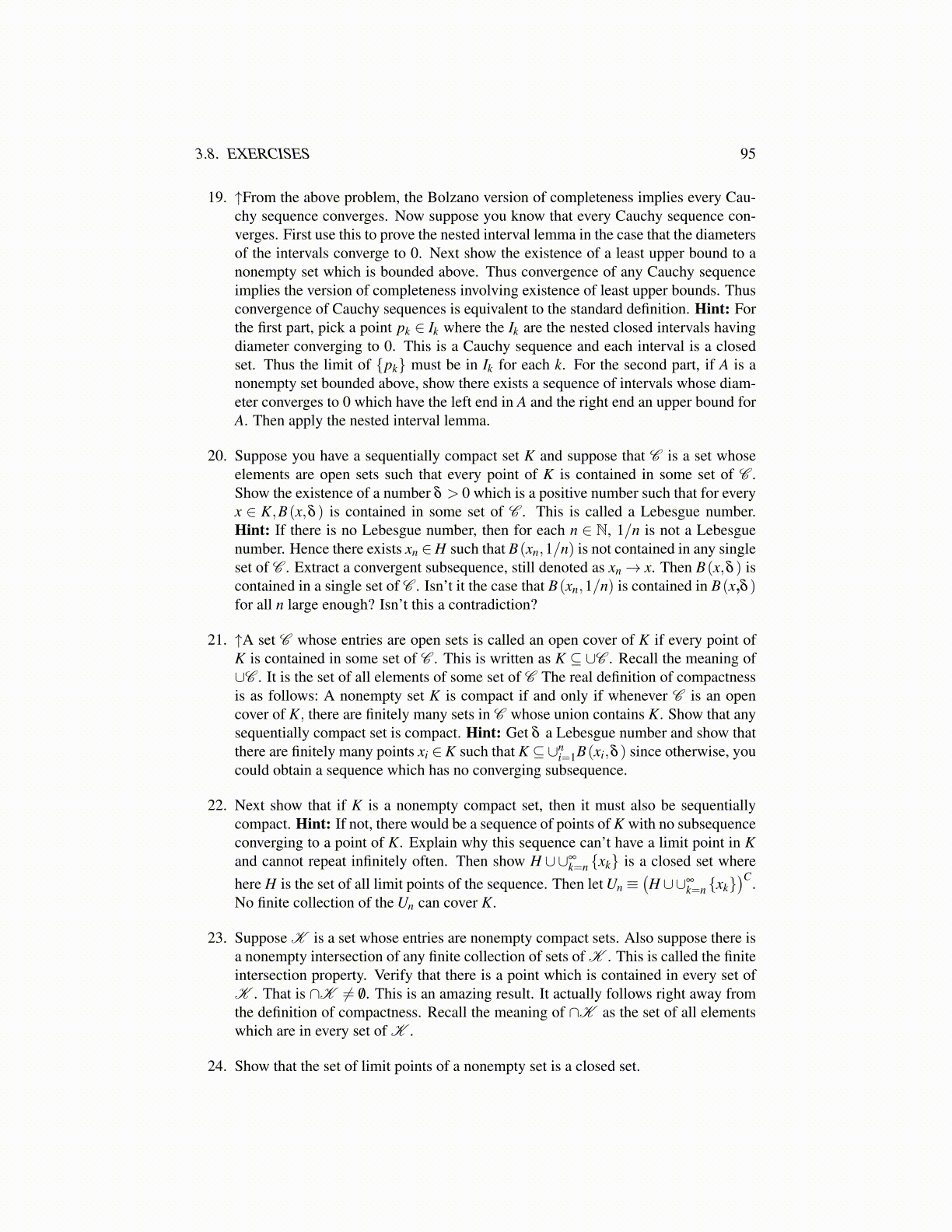
3.8. EXERCISES 95
19. ↑From the above problem, the Bolzano version of completeness implies every Cau-chy sequence converges. Now suppose you know that every Cauchy sequence con-verges. First use this to prove the nested interval lemma in the case that the diametersof the intervals converge to 0. Next show the existence of a least upper bound to anonempty set which is bounded above. Thus convergence of any Cauchy sequenceimplies the version of completeness involving existence of least upper bounds. Thusconvergence of Cauchy sequences is equivalent to the standard definition. Hint: Forthe first part, pick a point pk ∈ Ik where the Ik are the nested closed intervals havingdiameter converging to 0. This is a Cauchy sequence and each interval is a closedset. Thus the limit of {pk} must be in Ik for each k. For the second part, if A is anonempty set bounded above, show there exists a sequence of intervals whose diam-eter converges to 0 which have the left end in A and the right end an upper bound forA. Then apply the nested interval lemma.
20. Suppose you have a sequentially compact set K and suppose that C is a set whoseelements are open sets such that every point of K is contained in some set of C .Show the existence of a number δ > 0 which is a positive number such that for everyx ∈ K,B(x,δ ) is contained in some set of C . This is called a Lebesgue number.Hint: If there is no Lebesgue number, then for each n ∈ N, 1/n is not a Lebesguenumber. Hence there exists xn ∈ H such that B(xn,1/n) is not contained in any singleset of C . Extract a convergent subsequence, still denoted as xn → x. Then B(x,δ ) iscontained in a single set of C . Isn’t it the case that B(xn,1/n) is contained in B(x,δ )for all n large enough? Isn’t this a contradiction?
21. ↑A set C whose entries are open sets is called an open cover of K if every point ofK is contained in some set of C . This is written as K ⊆ ∪C . Recall the meaning of∪C . It is the set of all elements of some set of C The real definition of compactnessis as follows: A nonempty set K is compact if and only if whenever C is an opencover of K, there are finitely many sets in C whose union contains K. Show that anysequentially compact set is compact. Hint: Get δ a Lebesgue number and show thatthere are finitely many points xi ∈ K such that K ⊆∪n
i=1B(xi,δ ) since otherwise, youcould obtain a sequence which has no converging subsequence.
22. Next show that if K is a nonempty compact set, then it must also be sequentiallycompact. Hint: If not, there would be a sequence of points of K with no subsequenceconverging to a point of K. Explain why this sequence can’t have a limit point in Kand cannot repeat infinitely often. Then show H ∪∪∞
k=n {xk} is a closed set wherehere H is the set of all limit points of the sequence. Then let Un ≡
(H ∪∪∞
k=n {xk})C.
No finite collection of the Un can cover K.
23. Suppose K is a set whose entries are nonempty compact sets. Also suppose there isa nonempty intersection of any finite collection of sets of K . This is called the finiteintersection property. Verify that there is a point which is contained in every set ofK . That is ∩K ̸= /0. This is an amazing result. It actually follows right away fromthe definition of compactness. Recall the meaning of ∩K as the set of all elementswhich are in every set of K .
24. Show that the set of limit points of a nonempty set is a closed set.